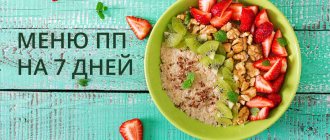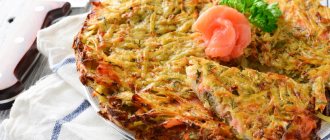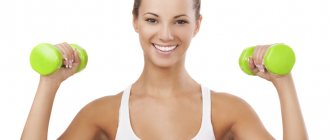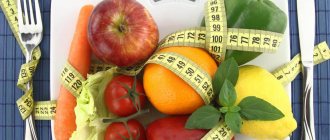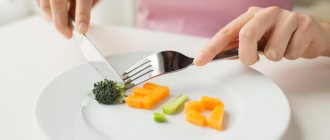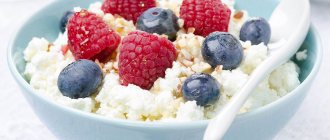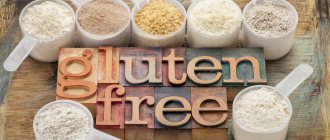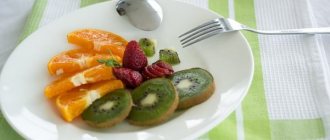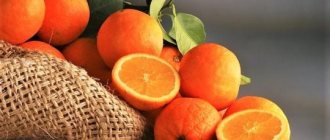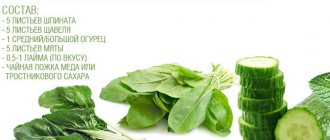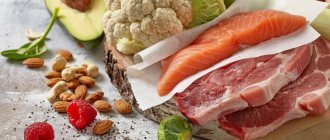No restrictions! If you want, you can even have hamburgers and soda! Find out how to calculate your individual calorie intake and lose extra pounds without stress and constant struggle with temptations!
- Reviews from those who have lost weight
Author: Kristina Lobanovskaya, doctor, practicing nutritionist Article updated: 05/18/2021
Weight is lost when the number of calories eaten per day is less than what the body requires. It is on this principle that most weight loss programs are based. Today we will talk about methods that require strict calorie counting, but this is precisely what explains their high effectiveness.
Advantages and disadvantages
The main advantage of calorie diets, which are based on the principle of calculating kcal, is the absence of strict prohibitions. You can enjoy your favorite dessert, eat a hamburger or drink a soda, but if their energy content covers your entire daily calorie limit, you will have to give up other food. That is why it is wiser to create a diet of low-calorie dishes in such a way that you do not have to go hungry and will be able to survive these days easier. Another advantage of such systems is efficiency. If you correctly calculate the body’s need for energy and create only a small deficit, then the kilograms will disappear willingly, and there will be no danger to health when losing weight. And thirdly, it’s developing self-discipline. Regularly counting calories and weighing portions develops the habit of strictly following the rules and not breaking them.
It would seem that the calorie diet is ideal in all respects, but it has one drawback. Write down everything you need to eat in a notebook, which you will always have to carry with you so as not to cross the line of what is permitted. And what was mentioned, what discipline should develop, becomes a real test for some, because you will have to constantly weigh everything that you intend to eat, since calculations “by eye” are not objective.
Recommended and excluded foods in dietary nutrition
Despite existing restrictions, the diet should include the greatest possible variety of raw materials for preparing dishes. For this purpose, first of all, low-calorie foods rich in vitamins, mineral salts, dietary fiber, biologically active substances (flavonoids, catechins, etc.), and omega-3 polyunsaturated fatty acids are used.
Also recommended in dietary nutrition:
- rye bread, which can be partially replaced with wheat bread made from wholemeal flour. Products made from premium and 1st grade wheat flour, butter and puff pastry are excluded;
- soups - 250-300 ml per reception, from various vegetables, with the addition of a small amount of potatoes or cereals: cabbage soup, borscht, okroshka, beetroot soup, soups in a weak low-fat meat or fish broth with vegetables, meatballs. Potato, cereal, legume, and dairy soups with pasta are excluded;
- meat (lean beef, veal, rabbit, limited lean pork), poultry (chicken, skinless turkey), beef jelly. Fatty meats, goose, duck, ham, frankfurters, sausages, boiled and smoked sausages, canned food are excluded;
- fish – mostly lean (pike perch, cod, etc.);
- seafood (mussels, scallops, oysters, etc.). Pickles, smoked fish products and canned food in oil, fish caviar are excluded;
- dairy products - milk and fermented milk drinks 1-1.5% fat, cottage cheese 2-5% fat, natural and in the form of cheesecakes, puddings, low-fat cheeses - limited. Avoid fatty cottage cheese, fatty and salty cheeses, sweet cheeses, cream, sweet yogurt, fermented baked milk, baked milk 1.5% fat;
- eggs – up to 3-3.5 pcs. per week (hard-boiled, soft-boiled, in a bag, in the form of an omelet with vegetables). Fried eggs are excluded;
- cereals – limited, for adding to vegetable soups. Crumbly porridge from buckwheat, barley, pearl barley - in a limited way and by reducing the amount of bread. Excluded: rice, semolina, pasta;
- vegetables - in a wide assortment, mostly low-calorie (10-30 kcal/100 g) raw and cooked, sauerkraut after washing. Among vegetables, preference should be given to: tomatoes, cucumbers, cabbage, celery, lettuce, radishes, radishes, sweet peppers, eggplants, zucchini, pumpkin, mushrooms, seaweed, etc. Dishes made from potatoes, beets, carrots, as well as salted and pickled ones are limited vegetables;
- fruits and berries of sour and sweet and sour varieties, with a calorie content in the range of 25-45 kcal/100 g. Preference should be given to cranberries, watermelon, cherry plum, lemon, tangerines, blueberries, blackberries, cloudberries, oranges, grapefruit, peaches, kiwi, plums , apples, quinces, strawberries, blueberries, etc. Sweet types are excluded: grapes, raisins, bananas, dates, etc.
- sweet dishes, sweets - jellies and mousses with methylcellulose, sorbitol, xylitol. Excluded: sugar, confectionery, jam, honey, ice cream, sweet drinks, jelly;
- fats (lipids) – butter (limited), vegetable oils. Meat and cooking fats are excluded;
- drinks - tea, coffee, low-sweet fruit, berry (preferably with pulp) and vegetable juices. Sweet drinks and juices (for example, grape), cocoa are excluded.
Low-calorie menu, 1200 kcal/day
As an example and guideline for reproducing at home, we present 2 options for one-day low-calorie menus recommended for overweight people.
Low-calorie menu – option 1. 1200 kcal/day. Breakfast 1:
- vegetable salad – 150 g,
- low-fat cottage cheese – 34 g,
- tea with milk without sugar - 1 glass;
Breakfast 2:
- fresh apples – 200 g;
- borsch ? servings – 250 g,
- vegetable cutlets with a piece of poultry meat – 100/50 g,
- dried fruit compote without sugar - 1 glass,
- bread with bran, black – 30 g;
Dinner:
Afternoon snack:
Dinner 1:
- fish – 50 g and vegetable stew – 150 g,
- plum juice without sugar - 1 glass,
- black bran bread – 30 g;
Dinner 2 (at night):
For the whole day: 20 g of bran - 10 g per first course and liquid fermented milk drink.
Low-calorie menu – option 2. 1500 kcal/day. Breakfast 1:
- Steam protein omelette – 100 g,
- salad of tomatoes, cucumbers and sweet peppers with sour cream – 170/10 g,
- coffee drink with milk – 130/50 ml;
Breakfast 2:
Dinner:
- Is the noodle soup vegetarian? servings – 250 g,
- boiled chicken – 100 g with boiled rice without salt – 150 g and olives – 50 g,
- fresh apple compote without sugar – 180 g;
Afternoon snack:
- rosehip decoction – 200 ml,
- soaked prunes – 100 g;
Dinner 1:
- boiled fish with vegetable oil – 100/5 g,
- eggplants stewed in sour cream sauce – 200 g,
- tea with milk – 130/50 ml;
Dinner 2 (at night):
For the whole day: rye bread, with bran – 100 g.
In order for the diet to bring maximum benefit, the individual need of the body for energy and valuable substances must be taken into account. To do this, you need to at least know the calorie content of the most popular foods and dishes in everyday nutrition. This data is provided in the relevant reference books.
Basic principles
At the very beginning of the diet, you need to calculate your daily calorie intake. When performing calculations, it is important to take into account age, gender, weight, height, and lifestyle. There are many formulas, we recommend using the one proposed by the American Dietetic Association and known as the Muffin-Jeor formula:
For women: 9.99*weight (in kilograms)+6.25*height (in centimeters)–4.92*age–161
The resulting value must be multiplied by the activity coefficient:
- No load – 1.2.
- Light activity (going to the gym up to 3 times a week, sedentary work at the computer) – 1.375.
- Average (3-5 trips to the gym weekly, or active work) – 1.55.
- High (intensive training 5-7 times a week, active or heavy physical work) – 1.725.
- Very high (training in the gym several times a day, exhausting workload) – 1.9.
For men = (9.99*weight (kg)+6.25 *height (cm)–4.92*age+5)*activity factor
Example: if you are a girl, you are 28 years old, you weigh 64 kg with a height of 168 cm and regularly visit the fitness center, then the daily portion of calories is calculated as follows: (9.99*64+6.25*168-4.92*28 -161)*1.375=1912.075. That is, to maintain weight you need to consume about 1900 kcal daily; if you want to lose weight, the portion must be reduced by 300 kcal (maximum 20%), but if you need to gain weight, then, accordingly, you need to increase the portion of calories by the same amount meaning.
Having calculated your daily caloric intake, it would be a good idea to reconsider your diet and lifestyle in order to improve the results of your diet. There are several rules that will help you lose weight and quickly see the coveted number on the scale:
- Eat well, there should be 3 main meals, with snacks between them. In this case, it is advisable to have breakfast no later than half an hour after waking up, and it is better to eat the last portion of food 3 hours before bedtime.
- Limit your consumption of sweets, fatty foods and starchy foods.
- Drink at least one and a half liters of clean water daily.
- Eat more plant foods.
- The preferred methods of cooking are stewing, boiling, steaming, baking; it is better to avoid fried foods.
- Sleep at least 7 hours a day.
- Include workouts in your daily routine, even if they are not intense; sometimes you can get by with a regular walk in the park, swimming or going to a disco.
Water removes waste and toxins from the body and normalizes intestinal function. In addition, the brain often mistakes thirst for hunger. Thus, maintaining a drinking regime is mandatory!
Who is the alcohol diet suitable for?
This weight loss option is best used while at home. Alcohol when losing weight is suitable for physically and mentally healthy people who are not prone to mood swings and increased blood pressure. Contraindications:
- chronic alcoholism or predisposition to it;
- liver disease (cirrhosis);
- renal failure;
- disturbances in the functioning of the endocrine system;
- Gastrointestinal diseases (gastritis, stomach ulcer);
- pregnancy, breastfeeding;
- mental disorders;
- age under 18 years;
- diabetes;
- use of medications.
Contraindications
Despite all the advantages of a calorie diet, it is still not suitable for some categories of people. So, pregnant women should give up the idea of losing weight by counting calories. During lactation, it is also undesirable to strictly limit yourself in food. For chronic diseases, gastrointestinal diseases, hypertension and diabetes, choosing a weight correction program should only be done under the supervision of a specialist. And, naturally, such a marathon is contraindicated for teenagers and elderly people.
Before the event, be sure to consult your doctor!
Rating of food delivery for weight loss
Delivery of food with calculated calorie content, ready-made diets. No more cooking and counting calories!
Go
Go
Three big flies in the ointment
First spoon - feeling hungry
Any drink with degrees stimulates appetite, causing the pancreas to quickly secrete digestive enzymes. Only a complete alcoholic, for whom his addiction overrides hunger, any other feelings, including common sense, can avoid feeling hungry after a glass of vodka or wine.
Forget about the beautiful words that you will want to eat less. Especially if you decide to lose weight the hard way, with a greatly reduced caloric intake.
The method with beer, despite reviews saying that it reduces the feeling of hunger, is not much different. Beer also perfectly stimulates the gastrointestinal tract, and in order to “get enough” of it, you need to consume at least several liters at a time. And how many small snacks are eaten with it, such as nuts, dried fish, smoked meats, etc.! And all because it stimulates the appetite.
The second spoon is the state of the gastrointestinal tract
This is directly related to the first point. You are unlikely to become addicted to alcohol from one glass of wine or a shot of whiskey in a week, but you will certainly ruin your stomach.
By drinking the treasured portion of a strong drink at night and not snacking, you stimulate the secretion of digestive juice, which, in the absence of other alternatives, will begin to digest the stomach lining. As a result, an alcoholic diet for weight loss will give you gastritis, and if you are prone to stomach ailments, maybe even an ulcer.
Third spoon - contraindications
This point is not particularly important for someone who is ready to abuse their body for the sake of promised quick results. If you are ready to “drink bitterly” for the dubious prospect of losing a few kilograms, will a number of restrictions like these stop you:
- hypertension;
- gastrointestinal diseases;
- cholelithiasis;
- neurological and psychiatric problems;
- pregnancy, breastfeeding;
- childhood and adolescence;
- a tendency towards alcohol addiction or such addiction in your immediate family;
- any chronic diseases in the stage of exacerbation or remission.
In other words: you can try the diet if you are as healthy as a moose and are not afraid that after finishing it you will have to contact a specialist in detoxification.
Recipes
In order for the diet to turn into a means to achieve a goal, and not into hard labor, we advise you to prepare delicious dishes that are not harmful to your figure. The menus above contain many different dishes, some of which you may not know how to prepare. Our recipes will come in handy.
Frittata with vegetables
You will need:
- chicken eggs – 3 pcs.;
- bell pepper – 1 pc.;
- onions – 1/2 pcs.;
- broccoli – 100 g;
- water – 5 tbsp. l.;
- olive oil – 2 tbsp. l.;
- spices - to taste.
Preparation:
- Chop broccoli, peppers and onions not very finely.
- Place in hot oil, add water and simmer for 10 minutes.
- Add spices, mix and remove from heat.
- Beat the eggs, not forgetting to add salt and pepper.
- Place the vegetables in a baking dish.
- Fill with egg mixture.
- Bake at 180 degrees for a quarter of an hour.
Cottage cheese casserole
You will need:
- low-fat cottage cheese – 450 g;
- egg – 2 pcs.;
- dried apricots – 2-3 pcs.;
- raisins – 10-15 pcs.
Preparation:
- Wash dried fruits. Fill with hot water for 5 minutes. Dry and cut.
- Combine cottage cheese with eggs and mix well.
- Add chopped dried fruits.
- Place the mixture in a silicone mold. Bake for about 40 minutes at 200 degrees.
Attention: before serving, the casserole must cool slightly; it is better not to remove it from the pan until this time.
Baked pollock
You will need:
- pollock – 2 small carcasses;
- lemon – 1/2 pcs.;
- olive oil – 2 tbsp. l.;
- dried rosemary – 5 g;
- salt, pepper, spices for fish - to taste;
- greens - for serving.
Preparation:
- We clean the fish, remove the fins, tail and entrails. Rinse under running cold water.
- Rub the carcasses with spices and sprinkle with rosemary.
- Drizzle with olive oil and lemon juice. Make sure that the pollock is well marinated on all sides.
- Place the fish on foil and wrap it up. Place in an oven preheated to 150 degrees for a quarter of an hour. Before serving, sprinkle with herbs.
Stewed spinach
You will need:
- spinach – 0.5 kg;
- leeks – 2 pcs.;
- parsley – 1/2 bunch;
- olive oil – 3.5 tbsp. l.;
- water – 80 ml;
- Provençal herbs, garlic, salt - to taste.
Preparation:
- Wash the greens. Let's dry.
- Cut the onion into thin rings.
- Finely chop the parsley.
- Heat the oil in a saucepan. Put onions in it. Stirring constantly, fry for 3 minutes.
- Now we add spinach leaves to the onion. Pour in warm water. Cover with a lid. Simmer for 3-4 minutes, stirring occasionally.
- Add chopped herbs, chopped garlic (if desired), spices. Cook for a couple more minutes, mixing all ingredients well. After the specified time, the dish is ready.
Broccoli soup
You will need:
- broccoli – 150 g;
- low-fat cheese – 30 g;
- skim milk – 150 ml;
- chicken broth – 250 ml;
- corn starch – 2 tsp;
- onions – 1/4 pcs.;
- carrots – 1/2 pcs.
Preparation:
- We clean the onion. We chop it up. Sauté in a saucepan or saucepan.
- Pour in the liquid ingredients. Cook for 5 minutes.
- We dilute the starch in a small amount of water so that lumps do not appear.
- Carefully pour the starch water into the milk-broth mixture, stirring constantly.
- When the broth begins to thicken, add grated carrots and broccoli. Mix.
- After cooking the vegetables, add grated cheese to the soup, remove the pan from the stove, stir for another 5 minutes, and then pour into plates.
Caesar with seafood
You will need:
- shrimp – 0.5 kg;
- grated parmesan – 1 tbsp. l.;
- crackers – 1/2 cup;
- lettuce - 1/2 bunch.
For the sauce:
- dietary mayonnaise (it is better to prepare it yourself) – 1 tbsp. l.;
- water – 1 tbsp. l.;
- parmesan – 1 tsp;
- black pepper - on the tip of a knife;
- garlic – 1 clove.
Preparation:
- Boil the shrimp in boiling salted water (just a couple of minutes). Place in a colander.
- Pour water into mayonnaise and mix.
- Add pepper, finely chopped garlic and Parmesan. Mix. The sauce is ready.
- In a salad bowl, mix peeled shrimp and croutons and place it all on lettuce leaves (they must first be torn by hand).
- Pour over the sauce and sprinkle with grated cheese.
Menu for a month (long-term option)
Choose according to your taste the proposed options for breakfast, lunch and dinner. There is one constant rule - a daily glass of dry red wine with or after dinner. Let's take a closer look at the alcohol diet menu.
Breakfast
- two-egg omelette, orange;
- cottage cheese casserole with dried apricots;
- oatmeal with low-fat milk with pieces of fruit;
- a sandwich made from a slice of whole grain bread, cheese and a piece of boiled meat, kefir;
- egg, unsweetened yogurt, pear.
Dinner
- beef borscht, a piece of rye bread;
- mushroom soup, a piece of boiled chicken with tomatoes;
- baked fish fillet with cabbage, tomato and cucumber salad;
- boiled squid with brown rice;
- spinach cream soup, a piece of rye bread, an orange;
- fish soup, a piece of black bread, your favorite fruit;
- stewed beef liver with pearl barley porridge;
- boiled beef, jacket potatoes, tomato;
- vegetable soup, chicken fillet with buckwheat.
Dinner
- chicken with coleslaw;
- soft-boiled egg, slice of bacon, apple;
- sea cocktail with cherry tomatoes;
- vegetable salad with cheese;
- low-fat cottage cheese with garlic and herbs.
Take 2-3 snacks, during which you eat one piece of fruit or drink a glass of milk, kefir, Varents, or fermented baked milk. You can eat a handful of dried fruits and nuts.
How to get out of a diet
The transition to a normal diet after strict calorie restriction inevitably leads to weight gain. This is why it is very important to get off the calorie diet correctly.
- When approaching the calorie intake calculated at the very beginning of the diet, try to increase the portion gradually (literally by 100 kcal per week).
- Minimize your consumption of fatty, fried, salty and smoked foods. Avoid fast food, soda, mayonnaise, ketchup and other store-bought sauces.
- Follow the drinking regime, namely drink at least 6 glasses of water daily.
- Play sports, walk more in the fresh air.
- Get enough sleep.
The essence or how it works
Alcohol in small quantities speeds up metabolism and helps the body break down fats. The diet includes foods that are quite nutritious, but low in calories. By limiting daily calorie intake, a person begins to lose weight. You can include a glass of champagne, a glass of good cognac or vodka, and a small mug of “live” beer in your daily diet. But the most useful alcoholic drink for weight loss is dry red wine.
Reviews and results
Evgeniy Semenovich, nutritionist:
“The 1200 kcal diet is a system for losing excess weight that is safe for human health. It is very simple, because you just need to stop eating fatty foods and reduce portions. The diet, after consultation with a doctor, can be practiced even by patients who have intestinal, liver and kidney diseases.
You should not stick to this diet for more than a month. After 30 days it can be repeated.
The diet will not only help you lose weight, but also develop the habit of eating right. When it ends, you will need to exercise and not indulge in fatty foods. This will allow us to maintain the achieved results.”
Reviews from those who have lost weight
Irina, 48 years old: “I decided to start eating right when I turned 40 years old. I eat mostly vegetables and give up oil. My cholesterol levels returned to normal and my blood pressure stabilized. I don’t practice the diet often – once a year. In 20 days I lose 8 kg, this is quite enough for me.”
Zhenya, 29 years old: “I like this diet because it has practically no prohibitions. You can eat everything, but in small portions. Recipes do not require long cooking, all products are available. In 2 weeks you can lose 5-7 kg.”
Anna, 29 years old: “I stayed on a 1200 calorie diet for a month. It was easy for me. I made the menu myself, which is very convenient. In 30 days I lost 8 kg – an excellent result.”
Albina, 35 years old: “The doctor recommended a 1200-calorie diet to me when my weight exceeded 80 kg. The diet was very easy for me. In a month I managed to lose 15 kg. Then I switched to my usual diet, but added a little calories. I also started playing sports. The result has lasted for 4 months.”
Where to start switching to proper nutrition
The transition to a new type of nutrition consists of five steps
:
- Eliminate foods that are not beneficial to the body
containing so-called “empty calories”. These are baked goods, confectionery, sweets, sausages and semi-finished products, mayonnaise, sauces.
- Eliminate alcohol
. Some studies show that such drinks affect neurons in the brain that control appetite. The more a person drinks, the more he eats. Also, drinking alcoholic beverages is often accompanied by various snacks and appetizers, which is extremely undesirable.
- Monitor your water balance
. Every day you need to drink at least 1.5 liters of clean water. The approximate norm is calculated using the formula: 30 milliliters per kilogram of ideal weight.
- Create a diet plan
. As already mentioned, it is necessary to divide the daily calorie intake into several meals. For everyone, set the most convenient time and stick to it. The schedule should be approximately the same for all days.
- Gain strength and patience
. Transitioning to a new lifestyle can be challenging.
In fact, the process of changing habits is extremely difficult. Ordinary advice will not help. You should not read reviews of people losing weight on the Internet about magic diets. In fact, only two percent of people are able to lose weight at home on their own without harm to their health. In all other cases, qualified assistance from weight loss specialists is required. These include nutritionists, psychologists, and personal consultants.
The transition to a new way of life should be gradual. Below are five basic rules. They must be introduced one after another, so it will be easier for the body to adapt.
So, the correct transition is based on the following principles
:
- Be sure to have breakfast
. Typically, those who skip their morning meals eat more throughout the day. Breakfast should be balanced and include proteins, fats, and carbohydrates.
- Don't rule out dinner
. It is no less important than breakfast. The only thing is that it is necessary to remove heavy, fatty, highly salty foods from it, since they can negatively affect the digestive processes, causing discomfort, heaviness, and bloating.
- Keep a food diary
. At first, clients are not limited in their usual food, but are asked to write down everything they eat during the day. At the end of the week, a weight loss specialist analyzes the records and points out problems. Clients themselves notice at what moments they should refrain from snacking. Also, a food diary helps to track food intolerances and understand which foods cause certain reactions in the gastrointestinal tract.
- Learn to count calories, proteins, fats, carbohydrates
. You can use a phone app or online resources.
To make the transition a little easier, you can find healthy alternatives to unhealthy foods. Now on the Internet there are many recipes for baking without gluten, lactose, sucrose, various homemade sausages, ham and much more.
Typically, people trying to lose weight go from one extreme to another, exposing the body to serious stress. Here are the main mistakes of losing weight
:
- Excessive reduction in calorie intake
. To lose weight, it is enough to reduce your consumption by 10-15 percent. Losing 1 kg per week is considered normal and the mildest.
- Skipping breakfast or dinner
.
- Adherence to different diets, especially high protein or low carbohydrate
.
The main rule of weight loss is balance. In nutrition, in training, in cosmetic procedures. This is the only way to get rid of extra pounds without harming your health and then maintain the result.
